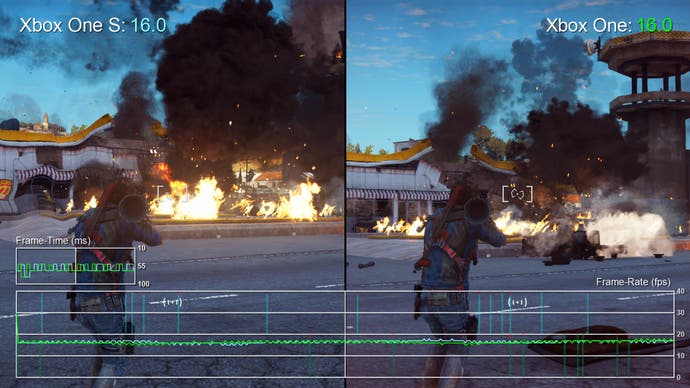Just Cause 3 revisited: has performance got better or worse?
Five patches later, Digital Foundry has disappointing results.
Grumblings of Just Cause 3's uneven PlayStation 4 and Xbox One performance has circulated since its late 2015 launch - a subject broached in our original Face-Off comparison. The recently released patch 1.05 gives us a chance to fully reassess the console experience, with a look at further-flung locales and a focus on the more riotous, gun-toting gameplay it offers. For a little perspective, all of our new tests also compare it to the previous patch 1.04, to see if there's been any real improvement.
Long story short: its worst drops are very similar to those we recorded around release, with physics-based destruction being the main culprit as expected. Our analysis below (focusing on the Lavanda on Rocca Blau regions) syncs movement up to get authentic action on the go, and despite a 30fps cap, we're looking at long stretches of 15 to 25fps playback once the action really kick off. Additionally, we've seen far less flattering scenarios from other players, with one capture in particular showing stuttering 0fps performance. We've yet recreate that exact same issue, but the drops we do have on capture ourselves are significant, and it does affect playability on both PS4 and Xbox One.
Of course, we're putting a big strain on Avalanche's engine with all these effects, and the physics-based carnage. This is a fair case for it however; destruction plays a big part in Just Cause 3's appeal, and if this core gameplay conceit is consistently producing results like this - as low as 15fps - we can appreciate people's frustration with its console performance. There's no apparent improvement on the latest patch 1.05 either, and in fact we see it fall visibly lower than 1.04 at points - though it's worth stressing that identical runs on the same patch can give a wild range of results, making any thing approaching like-for-like testing extremely challenging.
This significant variance between runs means we can't 100 per cent claim a change in performance between 1.04 and 1.05. However, this points to another issue with the game; the unpredictability of its drops. One theory is its online component plays a role in sporadic drops, with running leaderboard stats and attempts to connect to servers potentially drawing on CPU resources, outside of the player's control. This could explain why we see frame-rates plummet at points where we'd expect no issues whatsoever.
Otherwise, the reasons for drops are more visible. Just Cause 3 is one of the best looking sandbox titles on console - a game that fires on all cylinders with its fixation on physics, and some incredible draw distances. But its tailoring clearly doesn't suit the CPU-limited nature of current-gen specs, and that merciless draw on PS4 and Xbox One resources leaves behind an unrefined experience. It's a disappointment both are left running like this even after five patches, and especially that each drop occurs precisely around the kind of destructive antics the game concept actively encourages.
In a direct comparison between PS4 and original Xbox One, performance is still in the same ballpark with patch 1.05 installed. It's sometimes higher on one than the other, but clearly we're seeing the same bottleneck around any action. It's again working in that 15-25fps range on each during a siege on a small Lavanda town, culminating in that petrol station explosion.

A re-test on the newer Xbox One S gave us a glimmer of hope, where its 7.1 per cent GPU overclock stood a chance at alleviating at least some of the strain we see here. But the reality is there's no perceptible performance benefits when re-testing Just Cause 3 on the newer model. Under the same conditions, the original machine's drop to 16fps still kicks in at the same stress point in matched gameplay.
With Microsoft confirming there's no boost to the console's 1.75GHz CPU clock, it's clear the game's ambitious (but altogether integral) use of Havok physics, AI and animations are the main cause - all aspects that combine to create a similarly aggressive drop.
Xbox One S was unlikely to resolve the problem to any drastic extent, but we at least hoped to see a small uplift. If there is an improvement on this newer revision, it's well hidden, and from the end-user's perspective it'll be an identical experience to the standard Xbox One model. A move to the more substantially upgraded Scorpio and Neo machines could give us more to shout about - assuming the hardware does support legacy titles, or if Avalanche recompiles the title for the newer hardware.
In the meantime though, the best hope Just Cause 3 players have is further optimisations from the developer itself. We sent our initial finding to Square-Enix a couple of days ago, and will update should Avalanche respond.


